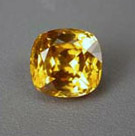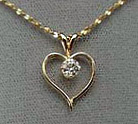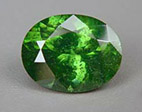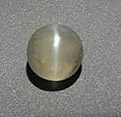


The beautiful, historically important gemstone, zircon, has unfortunately, in recent years been tarnished by its name-only similarity to cheap, ubiquitous, synthetic cubic zirconia. The two are totally distinct in their chemistry, optical properties and origins, though.
A natural gemstone, which occurs in various colors; zircon is found in many Asian countries, notably Cambodia and Sri Lanka as well as in Brazil, Australia and East Africa. Colorless when pure, zirconium silicate takes on various shades due to impurities. The most common color in the natural rough is yellowish brown.
The original diamond simulants, colorless or "white" zircons, if well cut, can be visually convincing, but are easily distinguished from diamond by their double refraction and the tendency to wear along facet edges. Brownish stones are often heated either with or without oxygen to achieve a colorless state or shades of blue, red and golden yellow. The rich, slightly greenish blue heated zircons had at one time been marketed as "starlite", but the term never caught on.
Some zircon crystals contain naturally radioactive thorium and uranium. Over time, this radioactivity breaks down the crystal structure so that such stones (always green) tend to an amorphous, glass-like state, with a lower refractive index and luster than the crystalline type. These unenhanced gems are referred to as "metamict" and are sought after collector's items.
The high birefringence of zircon makes it necessary for the cutter to orient the table of the stone to the optic axis; otherwise the interior may look fuzzy, due to facet image doubling. Round stones are often given a "zircon" cut which is similar to a standard round brilliant cut with an extra tier of facets at the culet.
Although use in rings should be limited to protective settings or occasional wear jewelry, in general, zircon is a magnificent jewelry stone. With a luster just short of diamond and a very high refractive index, exceptional brilliance is possible when a piece is well cut and polished. That stones with light body color may show strong dispersion is a bonus. Collectors appreciate the many color forms but especially seek out reds and greens.





Medium dark, pure blue stones have the highest value, followed closely by those with a saturated greenish blue color. Red stones (always with some orangey hue) in larger sizes also command relatively high prices. Cut is an important factor in value as the vast majority of zircons in the market, especially blues, have been native cut. A custom cut, therefore, enhances value. Sizes of zircon rough is not as limited as in some species, so although there is some premium per carat for larger stones it is not exponential. Cat'seye stones are quite rare in this species and especially valued.